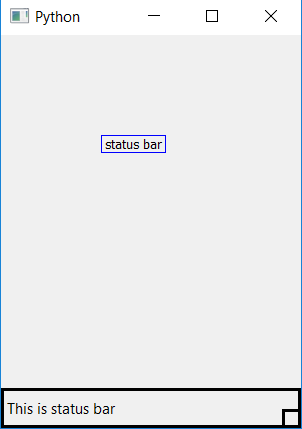Sabemos que podemos cambiar el tamaño de la ventana de la aplicación PyQt5, pero cuando cambiamos el tamaño de la ventana, la barra de estado también cambia de tamaño según el tamaño de la ventana. Al reducir el tamaño de la ventana, podemos establecer el tamaño mínimo para que la barra de estado no se pueda reducir más. En este artículo, veremos cómo hacer esto, para hacerlo usaremos el método setMinimumSize().
Sintaxis: self.statusBar().setMinimumSize(ancho, alto)
Argumento: Toma dos enteros como argumento, es decir, ancho y alto.
Acción realizada: Establece el tamaño mínimo de la barra de estado.
Código:
from PyQt5.QtCore import *
from PyQt5.QtGui import *
from PyQt5.QtWidgets import *
import sys
class Window(QMainWindow):
def __init__(self):
super().__init__()
# set the title
self.setWindowTitle("Python")
# setting the geometry of window
self.setGeometry(60, 60, 600, 400)
# setting status bar message
self.statusBar().showMessage("This is status bar")
# setting border
self.statusBar().setStyleSheet("border :3px solid black;")
# setting minimum size of status bar
self.statusBar().setMinimumSize(300, 40)
# creating a label widget
self.label_1 = QLabel("status bar", self)
# moving position
self.label_1.move(100, 100)
# setting up the border
self.label_1.setStyleSheet("border :1px solid blue;")
# resizing label
self.label_1.adjustSize()
# show all the widgets
self.show()
# create pyqt5 app
App = QApplication(sys.argv)
# create the instance of our Window
window = Window()
# start the app
sys.exit(App.exec())
Producción :
Publicación traducida automáticamente
Artículo escrito por rakshitarora y traducido por Barcelona Geeks. The original can be accessed here. Licence: CCBY-SA